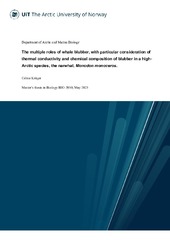| dc.description.abstract | Blubber in marine mammals is a multifunctional tissue, serving critical roles in thermoregulation, energy storage, endocrine regulation, and hydrodynamics. By providing insulation against cold, acting as a dense energy reserve, secreting hormones such as leptin to regulate metabolism, and streamlining the body for efficient swimming, blubber supports survival in diverse and often extreme environments. This study focuses on the narwhal (Monodon monoceros), a high-Arctic cetacean that relies on blubber to endure the severe Arctic climate. Specifically, we investigate the thermal conductivity, lipid stratification, histological adaptations, and functional differentiation of narwhal blubber, comparing it to other marine mammals.
Blubber samples from two male narwhals were analyzed for thermal conductivity using a conductivity meter, lipid content via the Folch method, fatty acid composition by gas chromatography, and microstructure through histology. Results revealed that narwhal blubber has a mean thermal conductivity of 0.19–0.20 W·m⁻¹·°C⁻¹, consistent with other Arctic species like the beluga whale (Delphinapterus leucas), which had 0.19 W·m⁻¹·°C⁻¹ in a single measurement in this study, but also similar to temperate dolphins, challenging assumptions about cold-adapted insulation in cetaceans. Stratification was observed: the outer blubber layer had higher conductivity (0.23–0.28 W·m⁻¹·°C⁻¹) and a larger proportion of monounsaturated fatty acids (MUFA: 59–64%) than the inner layer, which showed lower conductivity (0.12–0.16 W·m⁻¹·°C⁻¹) and higher proportion of saturated fatty acids (SFA: ~30%). The blubber had an overall high lipid content (>80%) compared to other marine mammals. Histology confirmed structural differentiation, with dense collagen in the outer layer and loose adipocytes internally, aligning with functional roles in locomotion and insulation.
The findings suggest narwhal blubber’s thickness and layered composition, rather than uniquely low conductivity, support its thermal resilience. | |


 English
English norsk
norsk
